![]()
![]()
![]()
Use LEFT and RIGHT arrow keys to navigate between flashcards;
Use UP and DOWN arrow keys to flip the card;
H to show hint;
A reads text to speech;
125 Cards in this Set
- Front
- Back
|
Define Vestibule
|
The space between the teeth ant the lips ro cheeks.
|
|
|
Define Oral Cavity Proper
|
The space internal to the teeth, where the tongue lies.
|
|
|
Define stratified squamous epithelium
|
The lining, which protects the inside of the mouth from abrasion due to hard or sharp foods.
|
|
|
Define Vermillion Border
|
The line between the red of the lips and the skin.
|
|
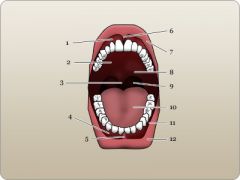
|

|
|
|
Name 5 purposes of the tongue
|
Contains taste buds for the ability to taste food and differentiate between sour, sweet, bitter, and spicy.
Manipulates food that is being chewed by gripping it and repositioning it between the teeth for mastication. Helps mix saliva with food in order to form a compact mass or bolus of food. During swallowing, the tongue helps to push the food bolus or liquids into the pharynx for further digestion. In speech, the tongue aids in the formation of various consonants, such as d, k, l, n, t, and w. |
|
|
Name and Define the 2 muscles of the Tongue
|
muscles allow the tongue to change position, protrude, retract, move laterally, or wiggle. Intrinsic muscles allow the tongue to change shape to flat, round, firm, and relaxed.
|
|
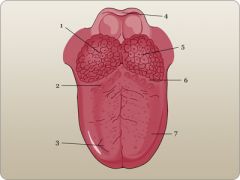
|

|
|
|
Name and Define the 2 distenct Salivary glands
|
The small intrinsic salivary glands are located throughout the mouth, in the mucosa of the tongue, palate, lips, and cheeks and are responsible for maintaining a moist mouth.
Large extrinsic salivary glands lie external to the mouth, but their ducts connect to it. They secrete saliva only when we eat or when we anticipate eating. There are three pairs of extrinsic salivary glands: parotid, submandibular, and sublingual. |
|
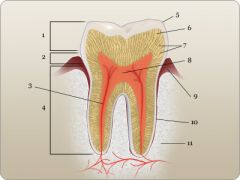
|

|
|
|
Name the 4 Layer or Tunica of the alimentary canal
|
Serosa - Outermost
Muscularis Submucosa mucosa - Innermost |
|
|
Define Distention
|
the state of being enlarged or allowing for an increased capacity. This occurs most notably in the stomach.
|
|
|
Define Absorption
|
the process of absorbing or assimilating nutrients, such as in the small intestine, or the absorption of water in the colon.
|
|
|
perdere (imperf)
|
perdevo,-i,-a
perdevamo perdevate perdevano |
|
|
Define Omentum
|
omentum also protects the organs from excessive rubbing that would break down outer organ walls.lesser omentum. The lesser omentum extends from the lesser curvature of the stomach to the underside of the liver.
greater omentum. The greater omentum extends from the greater curvature of the stomach to the transverse colon. |
|

|
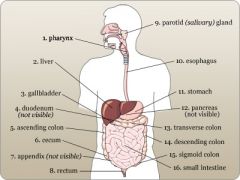
|
|

|
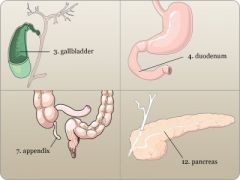
|
|
|
Define Cardiac Orfice
|
the junction between the esophagus and the stomach. This is also frequently referred to as the GE junction (gastroesophageal junction). Although no true sphincter exists at this point, the muscles here are in a constant state of contraction in order to prevent the stomach contents from flowing backward.
|
|
|
Define Fundus
|
is the dome-shaped portion of the stomach that extends slightly above the cardiac orifice.
|
|
|
Define the Body of the Stomach
|
is the widest portion and is located between the lesser and greater curvatures.
|
|
|
Define Pylorus
|
is the last area of the stomach, just before the duodenum.
|
|
|
Name and Desribe the 3 divisions of the Small Intestine
|
duodenum (This receives secretions from the liver and the pancreas)
jejunum ileum (The small intestine makes the transition to the large intestine here through what is called the ileocecal valve) |
|
|
Name the 4 Divisions of the Large intestine
|
Cecum, Colon, Rectum, Anus/Anal Canal
|
|
|
Define Cecum
|
The cecum opens into the colon and has the appendix, a small finger-like projection that is attached to its medial portion
|
|
|
Define Colon
|
Different areas of the colon have specific terms assigned to them. At approximately the liver, the colon bends sharply, and this area is referred to as the hepatic flexure. The colon then extends in a horizontal direction, and that portion is called the transverse colon. At the left abdominal wall, there is another sharp bend in the colon. This is called the splenic flexure and is the beginning of the descending colon, or that portion of the large intestine that goes downward (descends). Finally, the colon terminates in an S-shaped bend that is referred to as the sigmoid colon.
|
|
|
Define Rectum
|
the rectum, which is a tube approximately 15 cm long located between the sigmoid colon and the anal canal.
|
|
|
Define Anus/Anal Canal
|
The anal canal forms a muscular opening in the muscles of the pelvic floor that is called the anus. This is surrounded by both involuntary and voluntary muscular sphincters.
|
|
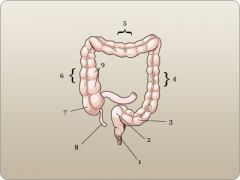
|

|
|
|
anorexia
|
A loss or total lack of appetite
|
|
|
borborygmi
|
The audible rumbling sounds of gas moving through the intestinal tract. This is the plural form. The singular form is borborygmus or borborygmos
|
|
|
chills
|
A shivering or a shaking
|
|
|
rigor
|
Shivering or trembling, usually accompanied by fever; also called chills.
|
|
|
constipation
|
Infrequent or difficult evacuation of feces. This term could be classified as either a symptom or a disease. Patients can subjectively relate that they are experiencing the discomfort of constipation, and it can also be the diagnosis.
|
|
|
obstipation
|
Constipation that continues for a prolonged period of time.
|
|
|
dysphagia
|
This is a subjective feeling of difficulty swallowing. It occurs when there is impaired progression of the food bolus from the pharynx to the stomach.
|
|
|
fever
|
An elevation in temperature above normal. This is also called pyrexia. If a patient has a fever, physicians will usually refer to that patient as being febrile.
|
|
|
afebrile
|
Not having a fever
|
|
|
flatus
|
Gas produced by bacterial action on waste matter in the intestines. Composed primarily of hydrogen sulfide and methane
|
|
|
bloating
|
The feeling of excessive gas in the colon.
|
|
|
belching
|
Expressing of excessive gas through the mouth.
|
|
|
flatulence
|
Expressing of excessive gas through the anus.
|
|
|
heartburn
|
A retrosternal sensation of burning felt in waves and arising upward toward the neck.
|
|
|
hematemesis
|
Vomiting of blood.
|
|
|
hematochezia
|
The passage of bloody stools.
|
|
|
melena
|
The term melena refers both to the passage of dark and pithy stools stained with blood pigment, and black vomit. Although the combining form is spelled with an A, it is important to note that the term melena or melenic stools is spelled with an E.
|
|
|
nausea
|
An unpleasant sensation in the epigastric and abdominal area, which often results in vomiting.
|
|
|
odynophagia
|
Pain during swallowing.
|
|
|
pallor
|
Paleness or the absence of skin color.
|
|
|
regurgitation
|
Flow in the opposite direction than is normal.
|
|
|
tenesmus
|
Straining, especially ineffective and painful straining during a bowel movement or urination.
|
|
|
vomiting
|
Also called emesis. The forcible expulsion of stomach contents through the mouth.
|
|
|
weakness
|
Lacking physical strength
|
|
|
weight loss
|
This is self-explanatory: losing pounds
|
|
|
achalasia
|
This is an impairment of normal esophageal peristalsis.It also affects the ability of the lower esophageal sphincter to relax. The most common symptoms are dysphagia, regurgitation, nocturnal cough, and chest pain.
|
|
|
anorexia nervosa
|
This is a mental condition characterized by an individual's refusal to eat enough to maintain a minimal body weight, usually fueled by an intense fear of becoming obese.
|
|
|
appendicitis
|
Inflammation of the vermiform appendix.
|
|
|
vermiform
|
The vermiform appendix specifically identifies the diverticulum of the cecum. However, healthcare professionals commonly drop the term vermiform when referring to this particular appendix.
|
|
|
atresia
|
The absence or closure of a normal body orifice or tubular organ.
|
|
|
bezoar
|
Tightly packed, partially digested agglomerations of hair or vegetable matter. Seeds, bubble gum, medication, and other materials can mimic true bezoars.
|
|
|
botulism
|
A type of food poisoning caused by the production of the bacteria Clostridium botulinum in improperly canned foods. It is characterized by vomiting, abdominal pain, difficulty seeing, dryness of the mouth and pharynx, dyspepsia, cough; it often results in death.
|
|
|
cheiloschisis
|
This is another term for cleft lip or harelip. It is a congenital abnormality.
|
|
|
cholecystitis
|
Inflammation of the gallbladder. There are different types of cholecystitis, the most common being chronic and acute. An acute infection generally indicates severe infection and often necessitates a cholecystectomy, which is removal of the gallbladder. This is an extremely common procedure.
|
|
|
cholelithiasis
|
The presence or formation of gallstones
|
|
|
cirrhosis
|
This refers to a group of liver diseases in which the normal hepatic structure is destroyed over time by nodules.
|
|
|
colitis
|
Inflammation of the colon.
|
|
|
dehydration
|
A condition that results from an excessive loss of body water.
|
|
|
dental caries
|
Tooth decay.
|
|
|
diarrhea
|
Abnormal frequency and liquidity of fecal discharges. Diarrhea is actually a symptom that suggests the presence of a disorder.
|
|
|
diverticulum
|
An abnormal bulge, pocket, or pouch formed from a hollow or tubular structure.
|
|
|
diverticula
|
The plural form of diverticulum.
|
|
|
diverticulitis
|
Inflammation of a diverticulum.
|
|
|
diverticulosis
|
The presence of diverticula with the absence of diverticulitis, especially in the colon.
|
|
|
Zenker diverticulum
|
The most common place that a diverticulum occurs is just below the pharynx.
|
|
|
dysentery
|
Any of a variety of disorders marked by inflammation of the intestines, especially the colon. The symptoms include pain in the abdomen, tenesmus, and frequent stools containing blood and mucus.
|
|
|
amebic dysentery
|
The most common type of dysentery, due to an ulceration of the bowel caused by amebiasis.
|
|
|
amebiasis
|
The state of being infected by amebae.
|
|
|
dyspepsia
|
General term which means impairment to the power or function of digestion. It often refers to discomfort in the epigastric region following a meal, or what many people call "indigestion."
|
|
|
enteritis
|
Inflammation of the intestine, especially the small intestine. Often this is combined (e.g., enterocolitis).
|
|
|
enterocolitis
|
Inflammation of both the intestine and colon.
|
|
|
cholera
|
A form of enteritis that is spread by food and water contaminated with feces. It is much more common in Third World countries.
|
|
|
esophagitis
|
Inflammation of the esophagus.
|
|
|
fecalith
|
An intestinal concretion (the process of becoming harder or more solid) formed around a center of fecal matter.
|
|
|
fistula
|
An abnormal passage or communication between two organs or from an internal organ to the surface of the body. There are several different types. It can occur because of trauma, infection, inflammation, degeneration, necrosis, or other causes.
|
|
|
gastitis
|
Inflammation of the stomach. This is often a result of a bacteria, and symptoms include anorexia, nausea, diarrhea, abdominal pain, and weakness. Gastritis is also a problem frequently associated with alcohol abuse.
|
|
|
gastroenteritis
|
Acute inflammation of the lining of the stomach and the intestines.
|
|
|
gastroesophageal reflux disease
|
The reflux of stomach contents into the esophagus. It is often represented by the acronym GERD (gastroesophageal reflux disease). This is usually caused by an incompetent lower esophageal sphincter. The major symptom is heartburn, although it can lead to several more severe disorders.
|
|
|
halitosis
|
Offensive breath. This can be real as the result of ingested substances, gingival disease, fermentation of food in the mouth, or associated with systemic diseases such as diabetic acidosis. It can also be imagined and the result of anxiety disorders, obsessive disorders, paranoia, or hypochondria.
|
|
|
hepatitis
|
Inflammation of the liver. Hepatitis can be due to viral, bacterial, or parasitic factors. They are generally classified by letters (i.e., hepatitis A, hepatitis B, hepatitis C). Some strains are transmitted through feces/oral contact, some through the blood (IV drug use), and some are sexually transmitted. Hepatitis can be chronic and active, in which case it is often fatal. Some forms are highly contagious.
|
|
|
hernia
|
The protrusion of a loop or knuckle of an organ or tissue through an abnormal opening. There are several classifications of hernias. The most common types follow.
|
|
|
abdominal hernia
|
The protrusion of some internal body structure through the abdominal wall.
|
|
|
hiatal hernia
|
The protrusion of the stomach above the diaphragm. There are both a sliding hiatal hernia and a paraesophageal hiatal hernia.
|
|
|
sliding hiatal hernia
|
A hernia in which the stomach and a section of esophagus which joins the stomach slide up into the chest through what is called the hiatus (gap/passage).
|
|
|
paraesophageal hiatal hernia
|
A hernia in which part of the stomach squeezes through the hiatus, but the esophagus and stomach stay in their regular locations. Of concern is that the stomach can become strangled/have its blood supply shut down.
|
|
|
inguinal hernia
|
A hernia into the inguinal canal. There are both direct and indirect inguinal hernias.
|
|
|
umbilical hernia
|
Protrusion of part of the intestine through the umbilicus.
|
|
|
Hirschsprung disease
|
Congenital megacolon, or a dilatation and hypertrophy of the colon due to the sustained contraction of the muscles of the rectosigmoid.
|
|
|
hypertrophy
|
The enlargement of an organ due to an increase in the size of its cells.
|
|
|
ileus
|
The temporary cessation of intestinal peristalsis, which often leads to obstruction. A common type is adynamic ileus.
|
|
|
adynamic ileus
|
A suspension of peristalsis because of paralysis or atony (lack of normal muscle tone or strength). This can be the result of drugs, toxemia, trauma, or surgery.
|
|
|
inflammatory bowel disease
|
This can be used to describe a variety of bowel disorders which are inflammatory in nature, whose etiology cannot be directly determined. There are two common types of inflammatory bowel disease which you should know: Crohn disease & ulcerative colitis.
|
|
|
Crohn disease
|
It is not known what causes Crohn disease; it can affect any part of the GI tract from the mouth to the anus, but is especially common in the ileocecal area. It frequently leads to obstruction and fistula and abscess formation.
|
|
|
ulcerative colitis
|
A chronic, nonspecific, inflammatory, and ulcerative disease that arises in the colonic mucosa and usually involves the rectum. Its etiology is also unknown and it is most often manifested by bloody diarrhea.
|
|
|
intussusception
|
This occurs when a segment of bowel advances and protrudes into the segment distal to it.
|
|
|
irritable bowel syndrome
|
Intermittent or constant abdominal distress and bowel dysfunction which has no demonstrable cause.
|
|
|
jaundice
|
A syndrome characterized by the bile pigment in the skin, mucous membranes, and sclerae with a resulting yellow appearance. There are many types of jaundice and most of these indicate a problem with the liver.
|
|
|
leukoplakia
|
A white patch on a mucous membrane that will not rub off. This occurs in the oral mucosa and is considered to be a premalignant (precancerous) lesion common in smokers.
|
|
|
malabsorption
|
Impaired intestinal absorption of nutrients. If the body is not absorbing nutrients properly, it can quickly result in an insufficiency of necessary nutrients. The combination of weight loss, diarrhea, and anemia indicate malabsorption.
|
|
|
mumps
|
An acute, highly contagious viral disease which causes painful enlargement of the salivary glands. Primarily infects children under age 15.
|
|
|
obstruction
|
The state or condition of being clogged or blocked.
|
|
|
pancreatitis
|
Inflammation of the pancreas.
|
|
|
parasites
|
A plant or animal which lives upon or within another living organism at whose expense it obtains an advantage. It is not uncommon for a parasite to be present in foods that are consumed, and they are also communicable via person-to-person contact.
|
|
|
Giardia
|
An intestinal protozoa that has a large sucking disc which adheres to the microvilli of the intestinal walls. There are many different kinds of parasites. However, except for Giardia, they are much more common in Africa and rarely impact Western medicine.
|
|
|
giardiasis
|
The infection that occurs with the presence of the Giardia parasite.
|
|
|
peptic ulcer disease
|
Inflammation and ulceration in the duodenum and stomach caused by gastric acid juice. Peptic ulcer occurs only if the stomach secretes acid.
|
|
|
Barrett esophagus
|
Barrett esophagus is a chronic peptic ulcer of the esophagus and is commonly seen in medical reports.
|
|
|
peritonitis
|
Inflammation of the peritoneum. Symptoms include abdominal pain and tenderness, constipation, vomiting, and moderate fever. Peritonitis sometimes follows abdominal surgery, such as an appendectomy.
|
|
|
pharyngitis
|
Inflammation of the pharynx. This is the most common etiology of a sore throat.
|
|
|
polyp
|
This refers to any mass of tissue that arises from the bowel wall and protrudes into the lumen. They may be either sessile or pedunculated. They vary considerably in size and histologic (microscopic tissue structure) characteristics.
|
|
|
sessile
|
Sessile means attached by a base.
|
|
|
pedunculated
|
Pedunculated means attached by a stem-like structure or stalk.
|
|
|
prolapse
|
The falling down or sinking of a part. This pathology can affect the GI system through anal prolapse and rectal prolapse (where skin of the anus and mucosa of the rectum protrude through the anus).
|
|
|
pruritus ani
|
Pruritus means itching. Pruritus ani is intense, chronic itching in the anal region.
|
|
|
Schatzki ring
|
A 2–4 mm mucosal structure, probably congenital in nature, which causes a ring-like narrowing of the lower esophagus.
|
|
|
ulcers
|
A defect or excavation of the surface of an organ or tissue. There are many kinds of ulcers (peptic ulcer disease, stress ulcers, ulcerative colitis, etc.), many causes for ulcers, and many treatments for ulcers.
|
|
|
volvulus
|
Intestinal obstruction that is due to a knotting or twisting of the bowel.
|

